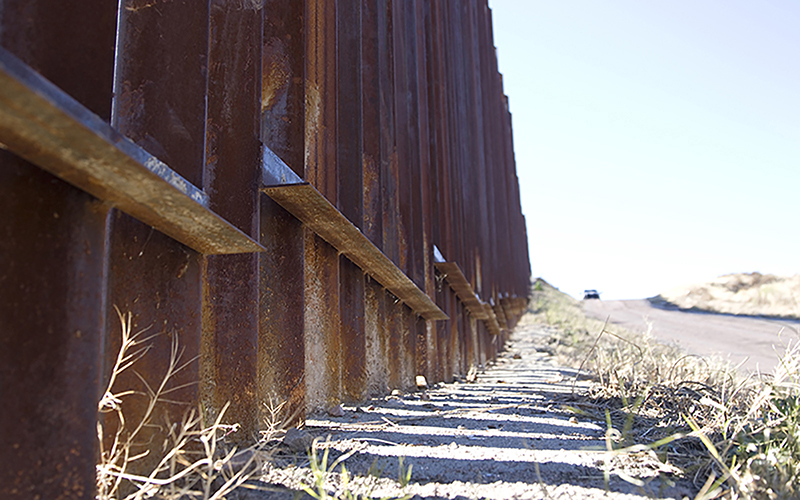WASHINGTON – President Donald Trump’s proposal for a southwestern border wall would do more than separate two nations – it would split another nation in half, say tribal advocates.
The Tohono O’odham reservation straddles the border with Mexico, with members on both sides of the boundary who cross regularly for many reasons, including for traditional medicines and religious ceremonies.
The tribe’s legislative council approved a resolution last month opposing the wall and calling for closer collaboration with federal officials to improve security along the tribe’s portion of the border.
The National Congress of American Indians followed suit weeks later with a resolution supporting the Tohono O’odham and calling on the federal government to negotiate with all border tribes on any action that would affect them.
“The Tohono O’odham Nation has been in existence and Native Americans have occupied these areas long before international borders,” said Robert N. Clinton, a law professor at the Sandra Day O’Connor College of Law at Arizona State University.
“The nation is fighting for more than their land,” Clinton said. “They’re fighting for religious access under the protection of the existing federal statutes.”
Trump’s pledge to build a wall along the nearly 2,000-mile southern border was a major part of his campaign and a pledge he repeated as recently as his address two weeks ago to a joint session of Congress, when he promised construction of a “great, great wall” with Mexico.
In his first week in office, Trump signed an executive order calling for the wall as one of the measures his administration would take to stop drug trafficking and illegal immigration.
“We’re committed to securing our borders to reduce crime, illegal drugs, human trafficking, especially in border counties,” Trump said at a roundtable with county sheriffs in early February.
“We’re not going to have the drugs pouring from the border like they have been,” he said to the sheriffs. “We’re stopping the drugs from pouring into our country and poisoning our youth.”
While the president emphasized the importance of working with local authorities to support “longstanding efforts to strengthen the bonds between the communities and the police,” tribal officials say they have been left out of the conversation.
Tribal nations are sovereign governments and the federal government “must practice consultation to keep a good relationship with the Native leaders,” said Rachel Rose Starks, senior researcher at Udall Center for Public Policy at the University of Arizona.
“Tohono O’odham leaders are among the many leaders who claim that President Trump did not consult them on building a wall,” Starks said.
Border security measures implemented by the Department of Homeland Security are “having a substantial direct effect on the Indian tribes” without consulting them first, the NCAI resolution said.
Critics point to an executive order in 2000 by then-President Bill Clinton that required “executive branches, agencies and officials to consult and collaborate with affected Indian Tribes” on policy.
But Starks said she is pessimistic that the federal government will live up to its obligations. She worries that tribes “still have to fight for their rights to move freely in their land.”
“The government basically gave itself permission to waive laws that make it hard for native tribes to take legal action,” Starks said.
Experts claim there are plenty of areas where tribes could challenge a wall.
Clinton, the law professor, stressed that the Tohono O’odham had religious rights that were protected by law that “interferes with the construction of the wall.” Trump and his team need to write a compelling proposal to justify building the wall using public funds, but Clinton said the tribe is not likely to accept compensation for the land involved.
A wall would affect not only the people who live along the border, but the wildlife and water there as well, which is why “the wall doesn’t make sense,” said John Dossett, a lawyer with NCAI. Dossett said tribal veterans who fought for this country also live on the Mexican side of the border.
“They often cross over, so building a wall would be extremely disruptive,” Dossett said.
There is currently no legal challenge by tribes and Dossett said “there needs to be lots of discussion before that happens.”
Clinton believes the Tohono O’odham are “at an advantage because they have a legal claim to their land and the right to control their land.” But he agreed that the issue has not reached that point yet.
“In dealing with modern Indian affairs, it is better for the government to negotiate with tribes than force litigation from Washington,” Clinton said. “The Trump administration should work with the tribe to negotiate a reasonable solution rather than hastily build a wall.”
But advocates noted that the Tohono O’odham already cooperate with the federal government, allowing federal agents to patrol their land and using their own funds for border control.
“Their border patrol is active and willing to fight off illegal immigration,” Clinton said of the tribe.
That needs to be recognized by Washington, Starks said.
“The Tohono O’odham Nation has done so much to collaborate with the U.S. government,” Starks said.
“They are Americans too,” she said. “The only difference is the border was imposed on them, they didn’t cross the border.”
